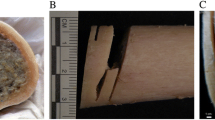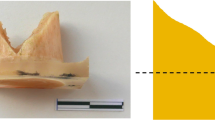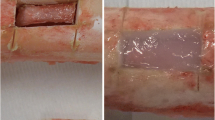Abstract
Metal structures—especially of stainless steel, titanium and their alloys (biomaterials)—are widely used in orthopaedic practice and the subject of constant study in bioengineering and preventive medicine. This study presents the first experience of forensic research into the presence of permanent tissue variations around metal implants in various bone structures for the purpose of identification, with particular reference to skeletal remains or severely decomposed corpses in the absence of other identifying elements. The evaluation was conducted on 12 corpses who had undergone osteosynthesis intra-vitam, whose implants were still in place or had been removed, in comparison with five controls who had never undergone osteosynthesis. Bone fragments taken during autopsy were subjected to histopathological and scanning electron microscope–energy dispersive electroscopy examination in order to reveal and characterise any metal particles originating from osteosynthesis. The study enabled the discovery of intra-bone metal particles in tissues treated by osteosynthesis even in bone areas where the implants had been removed and even where there were no longer any radiological signs of their application. These results are therefore of considerable forensic importance, especially in the area of identification, providing a valid means of recognition beyond that of the well-established use of in situ metal implants.



Similar content being viewed by others
References
Black J (1988) Does corrosion matter? J Bone Joint Surg 70-B:517–520
Zaffe D, Bertoldi C, Consolo U (2004) Accumulation of aluminium in lamellar bone after implantation of titanium plates, Ti-6Al-4V screws, hydroxyapatite granules. Biomaterials 25(17):3837–3844
Dos Santos TI, De Oliveira PT, Rosa AL et al (2007) Histological and histomorphometric analysis of the bone–screw interface in the mandibular body after using a 2.0-mm miniplate system: an experimental study in dogs. J Oral Maxillofac Surg 65(11):2169–2175
Franchi M, Bacchelli B, Martini D et al (2004) A. Early detachment of titanium particles from various different surfaces of endosseous dental implants. Biomaterials 25(12):2239–2246
Franchi M, Orsini E, Martini D et al (2007) Destination of titanium particles detached from titanium plasma sprayed implants. Micron 38(6):618–625
Martini D, Fini M, Franchi M et al (2003) Detachment of titanium and fluorohydroxyapatite particles in unloaded endosseous implants. Biomaterials 24(7):1309–1316
Matthew R, Frame JW (1998) Ultrastructural analysis of metal particles released from stainless steel and titanium miniplate components in an animal model. J Oral Maxillofac Surg 56(1):45–50
Moberg LE, Nordenram A, Kjellman O (1989) Metal release from plates used in jaw fracture treatment. A pilot study. J Oral Maxillofac Surg 18(5):311–314
Nazzal A, Lozano-Calderón S, Jupiter JB et al (2006) A histologic analysis of the effects of stainless steel and titanium implants adjacent to tendons: an experimental rabbit study. J Hand Surg 31A(7):1123–1130
Gores RJ, Hayes CK, Unni KK (1989) Postmortem examination of six maxillary core-vent implants: report of a case. J Oral Maxillofac Surg 47(3):302–306
Hirai H, Okumura A, Goto M et al (2001) Histologic study of the bone adjacent to titanium bone screws used for mandibular fracture treatment. J Oral Maxillofac Surg 59(5):531–537
Rohrer MD, Bulard RA, Patterson MKJR (1995) Maxillary and mandibular titanium implants 1 year after surgery: histologic examination in a cadaver. Int J Oral Maxillofac Implants 10(4):466–473
Torgersen S, Gjerdet NR, Erichsen ES et al (1995) Metal particles and tissue changes adjacent to miniplates. A retrieval study. Acta Odontol Scand 53(2):65–71
Bennett JL, Benedix DC (1999) Positive identification of cremains recovered from an automobile based on the presence of an internal fixation device. J Forensic Sci 44(6):1296–1298
Blau S, Robertson S, Johnstone M (2008) Disaster victim identification: new applications for postmortem computed tomography. J Forensic Sci 53(4):956–961
Kahana T, Ravioli JA, Urroz CL et al (1997) Radiographic identification of fragmentary human remains from a mass disaster. Am J Forensic Med Pathol 18(1):40–44
Simpson EK, James RA, Eitzen DA et al (2007) Role of orthopedic implants and bone morphology in the identification of human remains. J Forensic Sci 52(2):442–448
Bush MA, Bush PJ, Miller RG (2006) Detection and classification of composite resins in incinerated teeth for forensic purposes. J Forensic Sci 51(3):636–642
Bush MA, Miller RG, Norrlander AL et al (2008) Analytical survey of restorative resins by SEM/EDS and XRF: database for forensic purposes. J Forensic Sci 53(2):419–425
Acero J, Calderon J, Salmeron JI et al (1999) The behaviour of titanium as a biomaterial: microscopy study of plates and surrounding tissues in facial osteosynthesis. J Craniomaxillofac Surg 27(2):117–123
Jonas L, Fulda G, Radeck C et al (2001) Biodegradation of titanium implants after long-time insertion used for the treatment of fractured upper and lower jaws through osteosynthesis: element analysis by electron microscopy and EDX or EELS. Ultrastruct Pathol 25(5):375–383
Bouakaze C, Keyser C, Crubézy E, Montagnon D, Ludes B (2009) Pigment phenotype and biogeographical ancestry from ancient skeletal remains: inferences from multiplexed autosomal SNP analysis. Int J Legal Med 123:315–325
Benazzi S, Stansfield E, Dilani C, Gruppioni G (2009) Geometric morphometric methods for three-dimensional virtual reconstruction of a fragmented cranium: the case of Angelo Poliziano. Int J Legal Med 123:333–344
De Angelis D, Sala R, Cantatore A, Grandi M, Cattaneo C (2009) A new computer-assisted technique to aid personal identification. Int J Legal Med 123:351–356
Molina DK, Martinez M, Garcia J, DiMaio VJ (2007) Gunshot residue testing in suicides: part I: analysis by scanning electron microscopy with energy-dispersive X-ray. Am J Forensic Med Pathol 28:187–190
Pye K, Croft D (2007) Forensic analysis of soil and sediment traces by scanning electron microscopy and energy-dispersive X-ray analysis: an experimental investigation. Forensic Sci Int 165:52–63
Neri M, Turillazzi E, Riezzo I, Fineschi V (2007) The determination of firing distance applying a microscopic quantitative method and confocal laser scanning microscopy for detection of gunshot residue particles. Int J Legal Med 121:287–292
Fairgrieve SI (1994) SEM analysis of incinerated teeth as an aid to positive identification. J Forensic Sci 39:557–565
Fassina A, Corradin M, Murer B, Furlan C, Guolo A, Ventura L, Montisci M (2009) Detection of silica particles in lung tissue by environmental scanning electron microscopy. Inhal Toxicol 21:133–140
Viel G, Cecchetto G, Fabbri LD, Furlan C, Ferrara SD, Mentisci M (2009) Forensic application of ESEM and XRF-EDS techniques to a fatal case of sodium phosphate enema intoxication. Int J Legal Med 123:345–350
Acknowledgements
The authors wish to thank Mr. Agostino Rizzi, C.T.E.R. of the Istituto per la Dinamica dei Processi Ambientali (IDPA), CNR di Milano, working at the “Ardito Desio” Earth Sciences Department at the University of Milan, for his cooperation and tireless help with the SEM/EDS analyses.
Author information
Authors and Affiliations
Corresponding author
Rights and permissions
About this article
Cite this article
Palazzo, E., Andreola, S., Battistini, A. et al. Release of metals from osteosynthesis implants as a method for identification: post-autopsy histopathological and ultrastructural forensic study. Int J Legal Med 125, 21–26 (2011). https://doi.org/10.1007/s00414-009-0394-z
Received:
Accepted:
Published:
Issue Date:
DOI: https://doi.org/10.1007/s00414-009-0394-z




